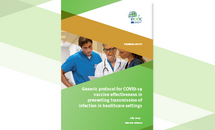Generic protocol for COVID-19 vaccine effectiveness in preventing transmission of infection in healthcare settings
The aim of the study protocol is to measure product-specific COVID-19 vaccine effectiveness to prevent transmission of SARS-CoV-2 infection from healthcare workers to their contacts, which can be either other patients or healthcare workers, in healthcare settings.
Executive Summary
Since the emergence in late 2019 of the novel severe acute respiratory syndrome – coronavirus 2 (SARS-CoV-2), which causes coronavirus disease 2019 (COVID-19), international collaboration has accelerated the development of COVID-19 vaccines. Within the EU/EEA, as of 16 June 2023, 12 vaccines, including four updated bivalent mRNA COVID-19 vaccines that contain both the original strain and either the Omicron BA.1 or BA.4-5 subvariants are authorised.
The aim of the study protocol is to measure product-specific COVID-19 vaccine effectiveness to prevent transmission of SARS-CoV-2 infection from healthcare workers to their contacts, which can be either other patients or healthcare workers, in healthcare settings. This document outlines a generic method to establish the study, collect data and undertake analysis as well as allowing for necessary local adaptions.
We propose a study design of a prospective cohort and the follow-up of contacts, both healthcare workers and patients, within a healthcare facility of a healthcare workers index case. The study setting is healthcare facilities participating in the VEBIS healthcare workers cohort study to estimate COVID-19 vaccine effectiveness, or other settings with similar attributes. The Vaccine Effectiveness, Burden and Impact Studies (VEBIS) healthcare workers study involves the regular screening of healthcare workers for possible SARS-CoV-2 infection so that both asymptomatic and symptomatic healthcare workers index cases can be identified using a consistent means of ascertainment.
The index case for the study will be healthcare workers with either an asymptomatic or symptomatic SARS-CoV-2 infection ascertained by regular screening. The contact of a healthcare workers index case will be defined as anyone who has had a contact with the healthcare workers in the three days prior to the index healthcare workers case confirmed SARS-CoV-2 infection status. The date of confirmed SARS-CoV-2 infection status of the healthcare
workers index case (i.e. index date) will be the date which the saliva sample or swab (nasal, OP or NP) was taken from the healthcare workers, who subsequently was tested positive by PCR. This date will be counted as T0.
There are two classes of contact: Patient or healthcare workers. All patients and/or healthcare workers who conform to the definition of a contact should only be recruited if they satisfy all following criteria of: Eligible for COVID-19 vaccination; COVID-19 vaccination is not contra-indicated; report a negative PCR for SARS-CoV-2 at T0; and have provided informed consent.
All identified contacts who have agreed to participate in the study should be approached for molecular testing for SARS-CoV-2 infection at T0 (up to three days after date of confirmed infection in the index healthcare workers case) and at T5 of the last test in contacts. The sample taken can include saliva samples or nasal, oropharyngeal or nasopharyngeal swabs.
Outcomes will be classified as follows: healthcare workers Index Case; Co-primary index case among any patient or healthcare workers contact; Probable co-primary index case among any patient or healthcare workers contact; Secondary case of any patient or healthcare workers contact whose SARS-CoV-2 infection status is confirmed by PCR that conforms to the algorithm of a negative SARS-CoV-2 PCR test of sample or swab taken at T0 and a
positive SARS-CoV-2 PCR test of sample or swab taken.





